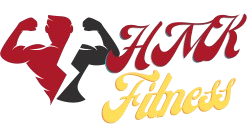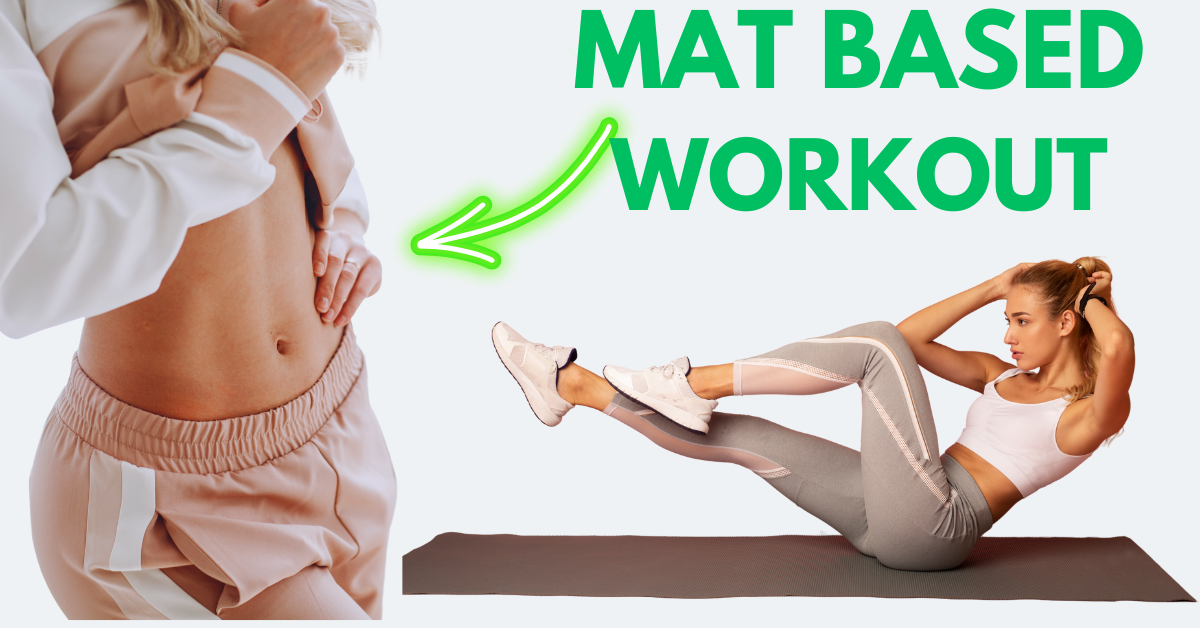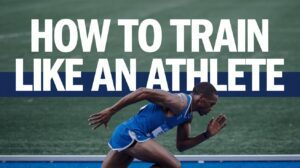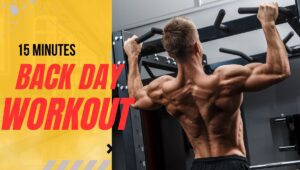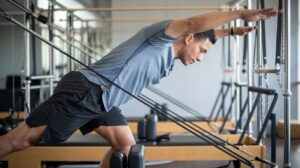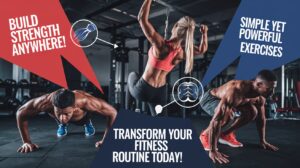Table of Contents
Toggle1. Introduction:
In this blog, you learn about mat workouts. Working out on a mat, which is easy to use and flexible and can be done nearly everywhere, may help keep you fit and active. For people new to fitness or athletes who want something different, mat workouts offer a low-impact way of improving strength, flexibility, and overall health. They are designed to put minimal pressure on the joints while offering a full-body challenge, making them perfect for all age levels and fitness abilities.
In this article, we will explore the numerous benefits of mat workouts, point out the essential equipment required for this activity, and introduce you to a step-by-step routine to get started. By the end, you will have integrated effective mat workouts into your exercise regime, thus keeping healthy and active wherever you are.
2. Benefits of Working Out on a Mat:
Mat workouts have become popular for good reasons—they have several advantages that cater to various fitness expectations, including enhanced agility or increased muscle mass, among other things. Here’s why introducing mat workouts into your routine might change everything.
Joint-Friendly Exercises:
The main reason mat workouts are famous is their low-impact nature compared to high-intensity exercises, which can lead to joint strains while practicing. They are ideal for individuals recovering from injuries or those willing to perform some physical activities without harming their joints.
Versatility for Different Workout Types:
Mat workout does not confine itself to one particular form of exercise only. Whether you enjoy yoga, Pilates, or calisthenics—the mat serves as a great base for multiple types of fitness programs. This diversity allows the mix-up of routines making training always pleasant and challenging enough.
Convenience and Portability:
Another significant benefit of these kinds of workouts is that they are much more flexible than other forms since they are done on a mat. All you need is a mat, and you can exercise anywhere, be it at home, in the park, or even during trips. As a result, one never misses any workout, no matter where he/she may be.
Enhanced Focus and Comfort:
Working out on a mat creates a dedicated space for your exercise routine, helping you focus better on your movements. The cushioning of the mat also adds comfort, especially during exercises that involve lying down or putting pressure on your knees and elbows.
By choosing to work out on a mat, you’re not only making a smart choice for your body but also setting yourself up for a flexible and sustainable fitness routine. The next time you’re looking for a workout that’s easy on the joints yet effective, consider unrolling your mat and getting started.
3. Essential Equipment for Mat Workouts:
Before starting your workout routine with the mat, ensure that you have all the necessary equipment that will maximally improve its effectiveness and make it comfortable. Despite being famous for their simplicity, some few items can greatly improve your experience and outcomes while performing mat workouts.
Choosing the Right Mat:
The first item that should cross your mind when thinking of a mat workout is the mat itself. In choosing a mat, you need to take into consideration its thickness, material, and texture. Thick mats are better as they tend to have more cushioning, which is important for exercises that involve kneeling or lying down. On the other hand, mats with non-slip surfaces are great for dynamic movements such as yoga and Pilates, where stability must be maintained at all times. Look out for a good quality, long-lasting, durable one that suits your type of exercise and taste.
Additional Accessories:
While a mat is the basis for your workout routine there are few other items you can include to make it even better. Resistance bands will raise the level of bodyweight exercises while also increasing strength. Alternatively, incorporating dumbbells into resistance training will enable you to focus on specific areas more effectively. Post-workout stretching and muscle recovery necessitate the use of foam rollers.
Proper Attire and Footwear:
Comfortable workout clothes that allow for a full range of motion are crucial in any type of physical activity. Go for clothes made from moisture-wicking fabric, which keeps you sweat-free during your session. Depending on what kind of exercise you’re doing, it may mean going barefoot, especially if it involves gripping with feet or flexing them, such as yoga or Pilates. However, lightweight training shoes that provide good support are ideal if you undertake workouts like HIIT on your mat.
The right equipment makes your workouts comfortable and effective, too. With good equipment, one sets up a safe environment for ensuring productive workouts, be it beginners or fitness fanatics who have been in the industry long enough since they were young; these basics can help anyone get more out of their moments in positioning themselves on top of their mats.
4. Warm-Up Exercises on a Mat:
A warm-up is essential before any workout to prepare your body for exercise and prevent injuries. When you do mat exercises, this warm-up will help to relax your muscles, increase blood circulation in them, and take off your joints from a fixed point. Here are a few warm-up exercises that are effective and can be done on the mat.
Cat-Cow Stretch:
The Cat-Cow stretch is an easy and gentle method of warming up the spine and increasing flexibility. Start on all fours with your hands under your shoulders and your knees under your hips. Inhale as you arch your back, dropping your belly toward the mat (Cow position). Exhale as you round your back, tucking your chin to your chest (Cat position). Continue this flow for about 1-2 minutes, concentrating on smooth, controlled movements.
Leg Swings:
Leg swings are great at warming up hip flexors and hamstrings, too. One leg lifts at a time while lying on one’s back with arms out for balance, then that same leg swings across the body over to the other side, keeping it straight before swinging it right back to where it started. Make sure you perform 10-15 swings per side in a deliberate, fluid manner so as not to strain muscles.
Hip Circles:
Aiding in the facilitation of hip joint movement and mobility. Begin on your mat with a table top position. Bring one knee off the floor and circle around with the knee in a controlled manner. Do 10 circles in one direction then do it again changing to the other side. Repeat with your other leg. This exercise focuses on your hip flexors, as well as preparing your lower body for more vigorous moves.
Arm Circles:
Shoulder and arm warming up is accomplished through performing quite simple movements known as arm circles. Stand on your mat feet shoulder-width apart from each other. Raise both arms sideways until they reach shoulder level extending them fully to both sides of you. Now, move arms in tiny circles and gradually increase these circles’ radiuses. Reverse the direction after 30 seconds, which has elapsed since starting this movement pattern. This exercise helps activate your shoulder muscles and increases blood flow to your upper body.
Dynamic Lunges:
Getting ready for dynamic lunges that will energize the lower part of your torso. Take one foot forward into a lunge position and come down onto the back knee towards the mat. Push off from front foot back to starting position, switch legs.Perform ten or twelve lunges per side, concentrating on form and balance.This exercise strengthens quads, glutes, and hamstrings, thus making it an excellent warm-up for any kind of mat workout.
Incorporating these warm-up exercises into your mat workout routine will help ensure your body is adequately prepared, reducing the risk of injury and improving your overall performance. Warming only takes minutes, but it is vital to setting a successful workout plan.
5. Types of Mat Workouts:
Yoga:
One of the most popular types of mat workouts is yoga. Flexibility, strength, and mind clarity are among its benefits. Yoga combines poses that stretch and strengthen muscles with practices of mindfulness and breathwork. Yoga on a mat is a full-body workout, which can either be Vinyasa, which involves flowing, or Hatha, which has slower moments as well. You choose among them.
Pilates:
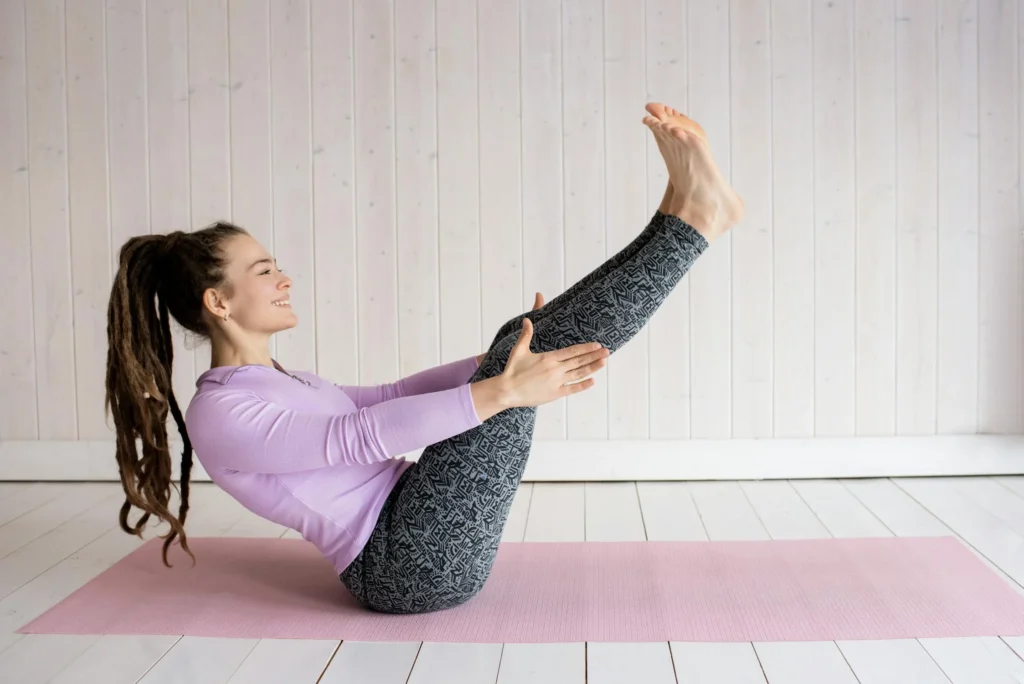
The main focus of Pilates is on the core and controlled movements with correct alignment. Your core will get stronger and better balanced if you perform such Pilates exercises as the Hundred or Leg Circles on a mat. This type of physical activity helps individuals strengthen their cores and increase their levels of flexibility while adding lean muscle mass into one’s physique.
Bodyweight Exercises:
Mat workouts are not limited to only yoga or Pilates because there are plenty of other ways to build strength and endurance using only your own weight. Examples include planks, push-ups, and squats, among others, which all require no equipment but instead can be done from a mat, thus keeping joints safe. The mat provides a comfortable surface for exercises that require you to be on your hands, knees, or back.
Dynamic Stretch Exercises:
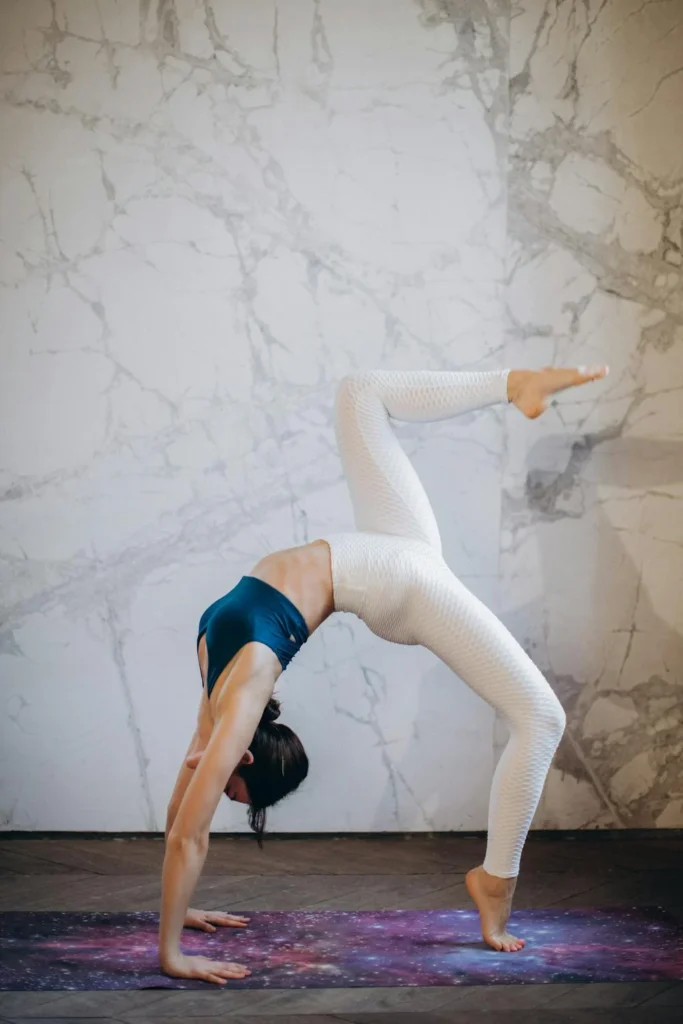

A mat makes stretching more comfortable and effective. Simply adding a stretching routine to your workout can help improve flexibility, increase range of motion, and prevent injuries. Aim for whole body stretches such as the Forward Fold, Seated Twist, and Butterfly Stretch, which work on different muscle groups and improve an overall sense of mobility.
Incorporating these diverse mat workouts into your exercise routine leads to healthiness and wellness with balance. Mat workouts provide a versatile and efficient solution whether you are looking to improve flexibility, build strength, or relax.
6. Sample Mat Workout Routine:
Here is a step-by-step workout that combines elements of strength, flexibility, and core stability to get you started on your mat workouts. This routine is designed to be done anywhere, making it perfect for those who want to do effective exercises without going to the gym. Let us now take a look at this balanced workout that can be easily followed from home.
Warm-Up: Cat-Cow Stretch:
Begin by gently performing the Cat-Cow stretch to warm up and activate your core muscles around the spine. Move smoothly between the Cat and Cow positions while concentrating on breathing in a 1- 2 minute time range.
Core Activation: Plank:
Proceed by assuming the Plank position, which is lying face down with hands flat near shoulders width apart underneath shoulders, then lift your entire body off the ground till it forms one straight line running from head down towards heels so that you engage your abdominal muscles while maintaining level hips throughout interpretation into plank position hold it should last about 30 seconds after which extend period each time incrementally by approximately ten till fifteen seconds.
Strength Building: Push-Ups:
Following the plank position, switch over to push-ups where arm length apart, then shoulder bit wide lower yourself until your chest touches the floor, push palms up, return starting place repeat the movement without exceeding fifteen times bracing your center all the way through.
Flexibility and Balance: Downward Dog:
Move from the push-up position into Downward Dog. This pose will stretch your hamstrings, calves, and shoulders while improving balance. Stay in this position for 30 seconds to a minute; make sure you press your heels down towards the mat while lengthening your back.
Lower Body Strength: Glute Bridges:
Lie on your back with feet on the floor and knees bent at a 45-degree angle between them. Push hard enough off the ground until your hips move up so that your whole body forms a straight line commencing from your neck and ending up at your knees. When you do glute bridge exercises, your glutes, hamstrings, and lumbar region are worked out. Do twelve to fifteen reps by squeezing your buttocks upon each rep completion.
Full-Body Stretch: Seated Forward Fold:
Finish the workout with a relaxing Seated Forward Fold. Sit with your legs extended straight in front of you on a mat or towel; take a deep breath, and let it out as you reach for your toes without bending your backbone. Draw it forward. During exercise, keep stretching for at least two minutes, feeling a deep stretching sensation in the hamstring muscles along the lower part of the waistline area.
Cool Down: Child’s Pose:
End by getting into a child’s pose, an easygoing stretch that allows both mind and body to rest after routine exercises. Together with breathing deeply, stay there for one to two minutes as you breathe deeply, thus allowing yourself to decompress before tackling anything else today or tonight.
This sample mat workout routine is complete—core strength, flexibility, balance, and relaxation. If you follow this routine regularly, you will form a strong foundation for your fitness journey right from the comfort of your mat.
7. Tips For An Effective Mat Workout:
Achieving maximum benefit from using mats in exercise necessitates more than just following programs. The details that make your training safe and effective are what matter. Here are some key tips that will help you get the most out of workouts on your mats.
Maintain Proper Form and Posture:
Maintaining good posture is one of the most important parts of any workout. Ensure that your body is correctly aligned, whether it’s a stretch or a plank or lunge. Poor form can result in injuries and decrease their effectiveness so concentrate on contracting targeted muscles with movements being controlled and precise.
Focus on breathing techniques:
Correct breathing techniques can greatly enhance your performance during workouts. When doing exercises such as yoga or Pilates, breathe in when preparing for movement and breathe out when executing moves – this helps oxygenate muscles while keeping centered throughout the exercise.
Stay Consistent and Progress Gradually:
Results from mat exercises hinge on consistency. Incorporate Matt’s exercises into your program several times each week on a regular basis. Begin with fewer repetitions and shorter sessions, but increase intensity and duration gradually as you gain more strength and endurance levels. Remember, change may be slow, but it’s crucial not to overdo things early enough.
Use a Quality Mat:
Investing in a very good quality mat can change how you work out completely.. This means that if there is any pressure exerted on critical parts like the knees, elbows, or back, then they will not feel much pain since good mats act as shock absorbers, thus preventing injury cases. Furthermore, they offer better grip, hence helping reduce risk during more dynamic moves such as slipping off.
Incorporate a Variety of Exercises:
To keep your workouts lively and rounded, mix up various types of exercise in your routine. Combine yoga, Pilates, body weights, and stretching to hit different muscle groups and avert workout boredom. Moreover, this variety will enable you to address distinctive types of fitness, such as power agility or balance.
Be Attentive to Your Body:
It is good that you acknowledge how your body feels before and after the training sessions. If there is any pain (not the normal ache from exhausting yourself) then pause for a while and check on your posture or adjust the position. It is important to ensure that you are working within your limits so it is good to listen to our bodies in order to prevent injuries.
By following these tips, you will improve the efficiency of your mat exercises and make them more interesting and sustainable in the long run. Remember, you want to build an achievable workout routine that supports your fitness goals while keeping you safe from harm or injury.
8. Common mistakes to avoid:
Although mat workouts are generally safe and available, some common errors can slow your progress or even cause injuries. Knowing these drawbacks can help maximize the effectiveness of your training and keep you focused on your fitness objectives. These are some of the mistakes to be alert for.
Skipping Warm-Ups or Cool-Downs:
One of the largest mistakes individuals make is skipping their warm-ups or cool-downs. Before exercising, warming up helps prepare muscles and joints, thereby reducing the risk of getting hurt, while cooling down assists in enabling one’s body to gradually go back into a rest state, consequently avoiding muscle stiffness. So as to ensure a secure and efficient exercise, it is always important to spend a few minutes on activities such as light cardio before starting any exercises.
Using the Wrong Type of Mat:
Not all mats are created equal. Using an inappropriate mat can ruin your workout experience completely. For example, if the mat is too thin, it might not offer enough cushioning needed by your joints, thus causing discomfort, whereas a mat with poor grip may lead to slipping during exercises. Depending on whether you intend to do yoga, Pilates, or body weight exercises, choose footwear specifically designed for this purpose.
Overextending or Improper Form:
Overstretching or having bad posture during workouts may result in straining a muscle or injuring oneself in general. This implies that every movement should be within its range and proper form will be maintained while doing each exercise correctly with no doubts regarding forms when one mirrors themself through video guidance, which makes sure that they follow well what should be done in sequence to achieve perfect workouts.
Neglecting Core Engagement:
Core engagement plays an important role in stabilizing many floor exercises, so much so that lack of it causes postural imbalances and reduces the efficiency of workouts, leading over time to higher chances of injury taking place when working out because most people do not engage their cores properly. In any case, make sure that you tighten your core muscles for stability and to support your moves while doing planks, press-ups, or even a touch of stretch.
Pushing Too Hard Too Soon:
Another common mistake is pushing yourself too much too soon. It’s only natural to want immediate results, but overexerting oneself can lead to fatigue and injury. Start with an intensity level commensurate with your present fitness level and gradually increase the difficulty as you become stronger and more comfortable with the exercises. There’s no need to exhaust oneself in one session since consistency over time always gives better results.
These are some errors to keep away from when practicing on a mat so that it becomes both safe and effective for exercise. The way we do our exercises and our bodies also determine if we will have good workout routines or not; hence, correct form should be observed at all times by choosing appropriate tools for training without exceeding one’s limits.
9. The Importance of Cooling Down:
After finishing your mat workout, it is essential to spend some time on a good cool-down and stretching routine. This stage helps your body move from an active condition to a resting state, thus reducing muscle stiffness and facilitating recovery. Cooling down is just as important as warming up in relation to flexibility maintenance and injury prevention.
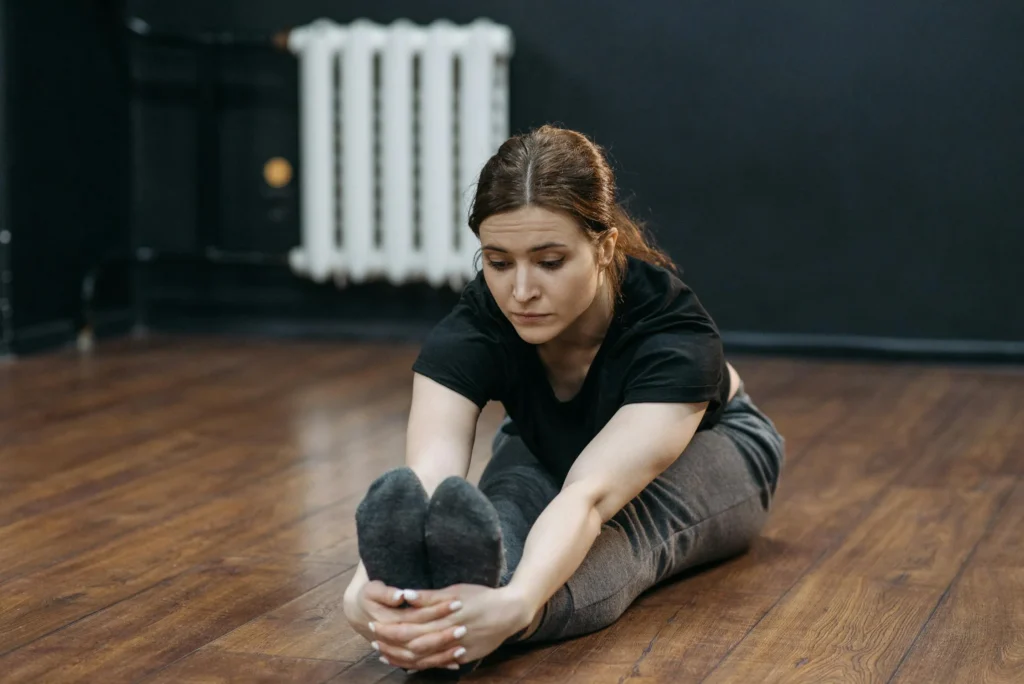

The Importance of Cooling Down:
Cool-down period gradually reduces your heart beat rates back to normal. It also prevents blood from pooling in the extremities hence minimizing chances of dizziness or fainting. A good cool down exercise is also important in eliminating lactic acid in your muscles which can help minimize post-workout soreness.
Effective Cool-Down Exercises:
Add easy exercises that gently diminish intensity to lower your body temperature slowly. Below are some effective cool-downs you can do with your mat:
- Child’s Pose: This is a relaxing stretch that elongates the spine and calms the mind. Stay in this position for 1-2 minutes while concentrating on deep breaths.
- Supine Twist: Lie on your back, bring one knee towards your chest, then gently twist it across your body, keeping your shoulders flat on the mat. Hold each side for 30 seconds to stretch out your back and hips.
- Standing Forward Bend: Stand up tall, take a deep breath in, exhale, and fold at the waistline, reaching forward for the legs or toes if possible. This hamstring stretch will release tension through the hamstrings.
Incorporating Full-Body Stretches:
Stretching before working out helps maintain flexibility and prevent muscle tightness; go for whole-body stretches that target key muscles used during activity:
- Seated Forward Fold: Sit with legs extended in front of you. Inhale, lengthen your spine. Exhale, reach toward your toes. Hold for 1-2 minutes, stretching your hamstrings and lower back.
- Cobra Pose: Lying face down with hands under shoulders. Press into palms to lift the chest off the floor, stretching abdominals and opening the chest 30-second hold.
- Butterfly Stretch: Sit with the bottoms of feet together, knees bent out to sides. Gently press elbows down on top of knees in order to push them towards the mat. This posture is good for inner thighs and hips.
Breathing and Relaxation:
Finish your cool-down with several minutes of deep breathing and relaxation. Lie on your back comfortably, close your eyes, and focus all your attention towards inhaling slowly but deeply. This step helps you calm down and reduces stress levels left over from exercise, thus leaving you feeling relaxed and centered at the end.
By including a complete cool-down and stretching routine, you will improve recovery, prevent muscle stiffness, and maintain the necessary flexibility for upcoming workouts. The latter ensures that you take care of yourself now so that you can perform at an optimum level in the long run.
10. Conclusion:
Adding mat workouts to your fitness routine offers an easy way to stay active regardless of your fitness level or location. Mat workouts offer a versatile solution that can be customized for any individual’s specific needs and goals, ranging from gentle yoga stretches to solid Pilates core-strengthening moves.
Working out on a mat has many benefits—it is kind to the joints, convenient, and requires little equipment. Beginners can exercise at home, build muscles, get more flexible, or do other low-impact workouts with mats. This article provides tips and routines for creating a balanced exercise program that will help them remain fit and healthy.
For instance, the convenience of mat workouts allows one to make exercising part of their everyday schedule regardless of whether they are in their house, on the road, or even at their desk in the office.
FAQS:
What type of mat is best for workouts?
Exercises such as yoga, Pilates, or bodyweight exercises can be done using good quality non-slip mats with proper cushioning.
Can I perform cardio exercises on a mat?
A mat can be used to perform mountain climbers and burpees, among other cardio exercises, with low impact. For better support, ensure that your mat has a good grip so that you do not slide off it.
How often should I engage in mat workouts?
It is advisable to have 3-5 sessions per week, including mat workouts, depending on fitness objectives and the overall exercise program.
Do Mat Workouts Help Weight Loss?
Mat exercises, combined with proper nutrition and other physical activities like jogging, help people shed weight by developing strength, flexibility, and endurance.
Do I need Other Equipment for Mat Exercises?
Resistance bands, dumbbells, foam rollers, and others may add variety or difficulty to your workout, while a padded rubberized surface is all you require for your routine floor workouts.
Are Mat Workouts Suitable for Starters?
Sure! These are ideal since they are gentle enough to meet everyone’s needs, irrespective of their fitness levels.
